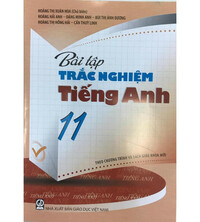Đề thi chọn học sinh giỏi môn Tiếng Anh lớp 11 năm 2016 có đáp án
Đề thi chọn học sinh giỏi cấp tỉnh môn Tiếng Anh lớp 11 tỉnh Nghệ An năm học 2015 - 2016 (Bảng A) là tài liệu ôn thi học sinh giỏi tiếng Anh mới nhất có kèm đáp án cụ thể dành cho các em học sinh lớp 11 ôn tập. Sau đây mời các em cùng làm bài và tham khảo đáp án cuối bài nhé!
Đề thi học sinh giỏi trại hè Hùng Vương lần thứ XI năm 2015 môn Tiếng Anh lớp 11
Đề thi học sinh giỏi cấp tỉnh môn tiếng Anh lớp 11 tỉnh Bà Rịa Vũng Tàu năm học 2013 - 2014
SECTION A: LISTENING
Part 1: You will hear five people talking about music. For questions 1-5, choose from the list A-H what each speaker says. Use the letters only once. There are three extra letters which you do not need to use.
| A. I get excited when I hear something new. | Your answers | |
| B. Music lets me express my emotions. | Speaker 1: | 1. ..... |
| C. I find it hard to listen to older songs. | Speaker 2: | 2. ..... |
| D. I'm a little bored with new music. | Speaker 3: | 3. ..... |
| E. I love playing different musical instruments. | Speaker 4: | 4. ..... |
| F. I sometimes get angry when I'm listening. | Speaker 5: | 5. ..... |
| G. The music I listen to relaxes me. | ||
| H. Certain types of music make me sad. | ||
Part 2: You will hear someone giving a talk about global warming. For questions 1-10, complete the sentences. Write NO MORE THAN THREE WORDS AND/OR A NUMBER for each answer.
THE TRUTH ABOUT GLOBAL WARMING
1. Our world is getting warmer with each (1)...... that passes.
2. Scientists measure (2)...... temperature changes.
3. Some studies show that the Earth's average temperature has risen by a couple of degrees in the last (3)....... years.
4. Some people hear news reports about solar flares, which are (4)....... on the face of the Sun.
5. Scientists have observed that from (5) ........, a time when solar activity was low, the Earth was absorbing more energy per square metre then it was reflecting bach into space.
6. It is true that plants "breathe" carbon dioxide in the same way that we "breathe" (6) ........
7. While some carbon dioxide is natural and good, too much is (7) .......... poisonous.
8. A study in 2007 noted that Greenland, an island near the Arctic Circle, may (8) ........ a longer growing season due to global warming. At the same time, though, the rest of the planet will suffer from (9) ............
9. Climate scientists have successful predicted weather (10) ......... since 1900, including the increase in temperatures.
SECTION B: READING
Part 1: Read the following passage and choose the letter A, B, C, or D to indicate the correct answer to each of the questions.
Most human diets contain between 10 and 15 percent of their total calories as protein. The rest of the dietary energy conies from carbohydrates, fats, and in some people, alcohol.The proportion of calories from fats varies from 10 percent in poor communities to 40 percent or more in rich communities.
In addition to providing energy, fats have several other functions in the body. The fat-soluble vitamins, A, D, E, and K, are dissolved in fats, as their name implies. Good sources of these vitamins have high oil or fat content, and the vitamins are stored in the body's fatty tissues. In the diet, fats cause food to remain longer in the stomach, thus increasing the feeling of fullness for some time after a meal is eaten. Fats add variety, taste, and texture to foods, which accounts for the popularity of fried foods. Fatty deposits in the body have an insulating and protective value. The curves of the human female body are due mostly to strategically located fat deposits.
Whether a certain amount of fat in the diet is essential to human health is not definitely known. When rats are fed a fat-free diet, their growth eventually ceases, their skin becomes inflamed and scaly, and their reproductive systems are damaged.Two fatty acids,linoleic and arachidonic acids, prevent these abnormalities and hence are called eseential fatty acids.They also are required by a number of other animals, but their roles in human beings are debatable. Most nutritionists consider linoleic fatty acid an essential nutrient for humans.
1. This passage probably appeared in which of the following?
A. A diet book B. A book on basic nutrition
C. A cookbook D. A popular women's magazine
2. We can infer from the passage that all of the following statements about fats are true EXCEPT
A. fats provide energy for the body B. economics influences the distribution of calorie intake
C. poor people eat more fatty foods D. alcohol is not a common source of dietary energy
3. The word "functions" in line 5 is closest in meaning to.........
A. forms B. needs C. jobs D. sources
4. The phrase "stored in" in line 7 is closest in meaning to.........
A. manufactured in B. attached to C. measured by D. accumulated in
5. The author states that fats serve all of the following body functions EXCEPT to.................
A. promote a feeling of fullness B. insulate and protect the body
C. provide energy D. control weight gain
6. The word "essential to" in line 12 is closest in meaning to.........
A. required for B. desired for C. detrimental to D. beneficial to
7. According to the author of the passage, which of the following is true for rats when they are fed a fat free diet?
A. They stop growing B. They have more babies
C. They lose body hair D. They require less care
8. Linoleic fatty acid is mentioned in the passage as.........
A. an essential nutrient for humans B. more useful than arachidonic acid
C. preventing weight gain in rats D. a nutrient found in most foods
9. The phrase "these abnormalities" in line 15 refer to...............
A. a condition caused by fried foods
B. strategically located fat deposits
C. curves on the human female body
D. cessation of growth, bad skin, and damaged reproductive systems
10. That humans should all have some fat our diet is, according to the author,...............
A. a commonly held view B. not yet a proven fact
C. only true for women D. proven to be true by experiments in rats
Part 2: Read the passage and answer the questions. Use your predicting skills. Note the type of questions. Read the following extract and answer questions 1–10.
Terror in the Mountains
A
What is incredibly beautiful yet absolutely terrifying and deadly at the same time? For anyone above the snowline in the mountains, there is little doubt about the answer. Avalanche – the word strikes fear into the heart of any avid skier or climber. For those unfortunate enough to be caught up in one, there is virtually no warning or time to get out of danger and even less chance of being found. The 'destroyer' of the mountains, avalanches can uproot trees, crush whole buildings, and bury people metres deep under solidified snow. Around the world, as more and more people head to the mountains in winter, there are hundreds of avalanche fatalities every year.
B
A snow avalanche is a sudden and extremely fast-moving 'river' of snow which races down a mountainside (there can also be avalanches of rocks, boulders, mud, or sand). There are four main kinds. Loose snow avalanches, or sluffs, form on very steep slopes. These usually have a 'teardrop' shape, starting from a point and widening as they collect more snow on the way down. Slab avalanches, which are responsible for about 90% of avalanche-related deaths, occur when a stiff layer of snow fractures or breaks off and slides downhill at incredible speed. This layer may be hundreds of metres wide and several metres thick. As it tends to compact and set like concrete once it stops, it is extremely dangerous for anyone buried in the flow. The third type is an isothermal avalanche, which results from heavy rain leading to the snowpack becoming saturated with water. In the fourth type, air mixes in with loose snow as the avalanche slides, creating a powder cloud. These powder snow avalanches can be the largest of all, moving at over 300kmh, with 10,000,000 or more tonnes of snow. They can flow along a valley floor and even a short distance uphill on the other side.
C
Three factors are necessary for an avalanche to form. The first relates to the condition of the snowpack. Temperature, humidity, and sudden changes in weather conditions all affect the shape and condition of snow crystals in the snowpack which, in turn, influences the stability of the snowpack. In some cases, weather causes an improvement in avalanche conditions. For example, low temperature variation in the snowpack and consistent below-freezing temperatures enable the crystals to compress tightly. On the other hand, if the snow surface melts and refreezes, this can create an icy or unstable layer.
D
The second vital factor is the degree of slope of the mountain. If this is below 25 degrees, there is little danger of an avalanche. Slopes that are steeper than 60 degrees are also unlikely to set off a major avalanche as they 'sluff' the snow constantly, in a cascade of loose powdery snow which causes minimal danger or damage. This means that slabs of ice or weaknesses in the snowpack have little chance to develop. Thus, the danger zone covers the 25- to 60-degree range of slopes, with most avalanches being slab avalanches that begin on slopes of 35 to 45 degrees.
E
Finally, there is the movement or event that triggers the avalanche. In the case of slab avalanches, this can be a natural trigger, such as a sudden weather change, a falling tree or a collapsing ice or snow overhang. However, in most fatal avalanches, it is people who create the trigger by moving through an avalanche-prone area. Snowmobiles are especially dangerous. On the other hand, contrary to common belief, shouting is not a big enough vibration to set off a landslide.
For questions 1–5, choose the correct heading for each paragraph A–E from the list of headings below (i-viii). There are more headings than paragraphs. Write your answers in the corresponding numbered boxes.
List of headings
i. Examples of Major Avalanches
ii. Stability of the Snowpack
iii. What Sets Off an Avalanche?
iv. An Expert's Comments
v. Steepness of Mountains
vi. Avalanche Peril
vii. An Avalanche Risk Table
viii. Types of Avalanche
1. Paragraph A 2. Paragraph B 3.Paragraph C
4. Paragraph D 5. Paragraph E







